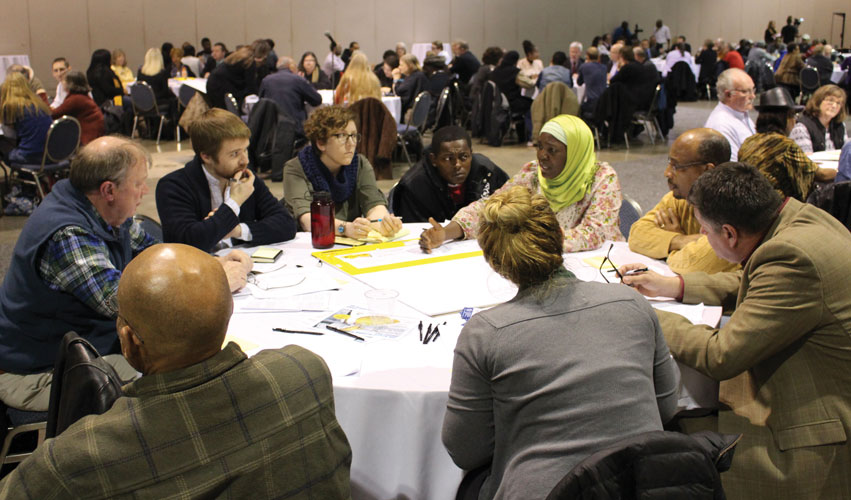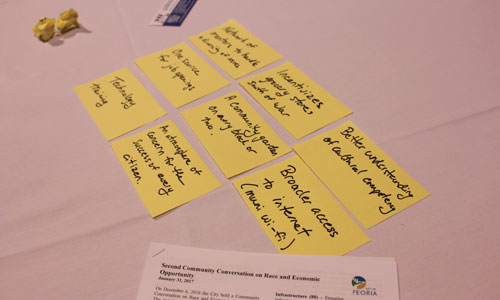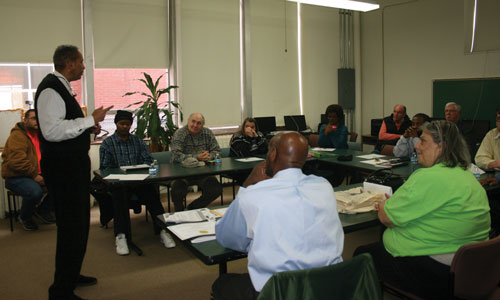
An ongoing community conversation provides an opening to acknowledge and address racial disparities in our region.
In cities across the nation, the economic and social distress that persists in low-income neighborhoods is a vexing problem, and Peoria is no exception. With the release of a report last fall citing the city as the worst place for African Americans to live in the U.S., the local community was shocked—and sparked into action. Multiple public discussions have drawn broad participation from area residents and community leaders, laying the groundwork for an open dialogue on the many factors that cause racial disparity. So what can be done to make Peoria a haven for equal opportunity, resources and growth? The conversation is multifaceted and ongoing—and all of us can be part of the solution.
Detailing Disparity
Released last fall, the report from 24/7 Wall St.—an online financial news company, not affiliated with The Wall Street Journal—provided quite a jolt to the community. Using statistical data focused on income, education, incarceration and health, the report attempted to create an index to “assess race-based gaps in access to resources and opportunities in each of the nation’s metropolitan areas.” Its findings were grim, including: a poverty rate four times higher for black Peorians than their white counterparts, incarceration levels nine times higher in the African-American community, and an unemployment rate triple that of white residents.
Soon after the report’s release, the Peoria city manager’s office responded with a nine-page memo, acknowledging these significant challenges while taking issue with the underlying data. “I was surprised about some of the statistics that they quoted,” explains Councilwoman Denise Moore. “We figured out those statistics did not necessarily reflect Peoria alone, but rather were an amalgamation of the five-county [region].”
Although the City reached out to 24/7 Wall St. to learn more about its data and methodology, the organization declined to release the material. Yet it wasn’t difficult to determine that much of the data was misleading, bending regional statistics to cast a negative light on the city itself. “It said we have 379,000 people in Peoria,” explains City Manager Patrick Urich. “They were looking at metro data, and then using ‘city’ as the descriptor.”
Citing a number of reputable sources, including the U.S. Census Bureau, City staff sought to clarify some of these distortions. The black population in the City of Peoria, for example, is 26.9 percent—not 9.3 percent, as stated in the report—while the poverty rate that was cited employed similar misrepresentations. Likewise, the report’s authors relied on statewide incarceration data to evaluate individual cities—further undercutting its authority.
 Despite questions about its data and methodology, Urich acknowledges that the report’s general findings cannot be ignored. “There is a big economic disparity between those who live in the 61605 zip code and the rest of the region,” he affirms. “[The report] is a recognition of knowing where we are, [and] that we have some challenges.” And it has sparked a wave of conversations about how to effectively address the significant racial inequities that do exist.
Despite questions about its data and methodology, Urich acknowledges that the report’s general findings cannot be ignored. “There is a big economic disparity between those who live in the 61605 zip code and the rest of the region,” he affirms. “[The report] is a recognition of knowing where we are, [and] that we have some challenges.” And it has sparked a wave of conversations about how to effectively address the significant racial inequities that do exist.
It Takes a Village
True to the report’s claims, Peoria’s African-American population faces profound challenges that far exceed the rest of the community, and economic disparities are chief among them. Low income levels and high unemployment rates, especially in the 61605 zip code, are the result of a long-term lack of resources and access to opportunity for black residents—issues of disparity that have been well known for years.
In 2015, the City of Peoria partnered with the National Resource Network (NRN), a federally funded program that helps U.S. cities tackle their most pressing challenges, to assess how it could move the needle forward, specifically on the south side. In January 2016, NRN released an assessment report, concluding that renewed economic and population growth “requires stabilizing the city’s urban core by comprehensively addressing the poverty challenges and lack of opportunity in the Southside neighborhoods.”
Pastor Marvin Hightower, current president of the Peoria NAACP, says these challenges are nothing new. “Aesthetically, you can tell there has not been a concerted effort toward investment in the community in 61605,” he notes. “Access is now starting to come around, [but] there’s been a lack of information flowing to where it needs to be.”
The underinvestment in areas of need, adds community activist Chama St. Louis, has had a significant impact on the ability of residents in those areas to succeed, and this affects everyone in the region—not just residents of the south side. “In order to fix the issue, the playing field has to be leveled,” she notes. “Ultimately, if the lower zip codes [like] 61605, or the state of black Americans keeps declining within the city… it’s going to reach other citizens who maybe think, ‘It doesn’t affect me.’ It’s not affecting you right now, but eventually, it will.”
Indeed, “the city’s prosperity is fragile,” emphasized the NRN in its assessment last year. Despite strong growth in other parts of the city, “the Southside’s limited contribution to the economic vitality of Peoria hinders the City’s ability to attract new industries and raise municipal revenues.”
In his recent State of the City address, Peoria Mayor Jim Ardis cited poverty as the root cause of so many of these challenges, including inequities in the public education system. While education is rightly seen as the key to breaking the cycle of poverty, the chronic lack of resources undercuts an individual’s ability to do so. This broken system has left many young adults without the skills they need for the 21st-century workforce.
 In addition, the inadequate representation of minorities in teaching and leadership positions is discouraging to students seeking role models in their schools. Sherry Cannon, founder and executive director of Hope Renewed Youth Conference, started the organization when her grandson entered the public school system. “[Black] children are 65 to 70 percent of District 150’s population,” Cannon notes. “Our kids need more people who look like them in this community.”
In addition, the inadequate representation of minorities in teaching and leadership positions is discouraging to students seeking role models in their schools. Sherry Cannon, founder and executive director of Hope Renewed Youth Conference, started the organization when her grandson entered the public school system. “[Black] children are 65 to 70 percent of District 150’s population,” Cannon notes. “Our kids need more people who look like them in this community.”
Without sufficient support systems, youth may drop out of school and associate with drugs and gangs—a “direct pipeline to prison,” claims James Bryson, founder of New Millennium Institute, which is working to address these concerns through a new workforce development initiative. If they aren’t addressed, he adds, the lack of hope will lead to a vicious cycle of victimization and resignation to the situation. “Living in poverty and crime can be comfortable if you get used to it,” he explains. “We have individuals who are participating in self-handicapping behaviors… I’ve seen a lot more violence, loss of respect for elders, parent disengagement in education. That village that we once had when I was growing up has been burned down.”
Call to Action
There’s no doubt the issues of racial disparity are highly complex and multilayered. They are built on inequities stemming from a protracted history of discrimination—both overt and systemic—and progress is impeded by the economics of a high-tech, globalized economy that has decimated job opportunities for the middle class. There are no easy answers, and it cannot be solved at the local level alone—especially in light of the chronic lack of funding for government entities, nonprofits and other organizations in a position to help.
But giving up is not an option, so area citizens and community leaders are coming together to sound a call to action. In early December, the City of Peoria hosted a public discussion at the Gateway Building to consider the tough questions and brainstorm ways to move forward. An overflow crowd—more than 300 concerned residents of all races, ages and backgrounds—signified the importance of this issue to the community, as well as the recognition that it impacts all of us, regardless of the zip code in which we live. More than 1,300 ideas were collected from participants and sorted into eight general areas: asset development, economic development, education, infrastructure, health, justice, workforce development and advocacy.

A second meeting, held on January 31st at the Peoria Civic Center, drew similar numbers—showcasing the staying power of this issue. After several more rounds of discussion, City staff announced the creation of work groups aligned with these topical areas and called for volunteers to participate in developing solutions.
As these groups are being assembled, Councilwoman Moore notes that Peoria’s citizens have a prime opportunity to play a substantial role in making a difference. “You [must] put in the work to hold us all—the city and citizens, and business and industry—accountable,” she declares. “We can make some things happen. But if people… don’t commit to putting in some time to affect change, there will be no change.”
The responsibility for tackling racial inequity, Urich adds, rests on the entire region, not just city residents. “Everybody has a part to play,” he declares. And there will be no single solution. From Bryson’s New Millennium Institute and Councilwoman Moore’s Minority Business Development Center, to city initiatives like the Peoria Area Diversity in Employment Action Team and Mayor’s Youth Program, to the myriad efforts of neighborhood associations, nonprofit organizations, business leaders and advocacy groups, a diverse mosaic of community efforts is needed. Most importantly, it involves everyone working together.
A Great Awakening
It’s vital for residents to get involved in politics and vote in local elections, says Pastor Hightower, and to keep in touch with the elected officials responsible for guiding the community toward action. “Get informed about the candidates that are running. What do they think? … How do they plan to help address the situation in those areas?”
“Holding people accountable for being fair, doing business right and following the law—that’s what we have to do,” adds Cannon. “We have to really get in there and start unpeeling layers—and not just accept that things have to be [this] way.” Progress won’t be easy, but with increasing numbers of citizens willing to step out of their comfort zones and get involved, there is hope. “There must be a recognition that this is not just a ‘black community problem,’” wrote Councilwoman Moore in an op-ed following the release of the 24/7 Wall St. report. “This is a Peoria problem! It will require a holistic approach and sustained commitment to meet the challenge.”
There does appear to be an awakening to the magnitude of these issues, both in Peoria and around the country, adds St. Louis. “People are just starting to come together… and I think that’s what makes this different.
“It’s one thing if I’m black and I’m pushing issues for my people—you expect that,” she says. “But it’s another thing if I can join forces with people of other races, and we’re all championing for equality.” That recognition—that we are all in this together—may well be the critical factor that determines our collective success as these efforts continue to move forward. iBi
If you are interested in participating in one of the city’s work groups, email City Manager Patrick Urich at citymanager@peoriagov.org.

